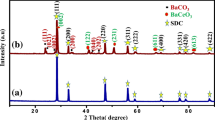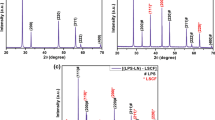Abstract
In this work, we prepare samarium-doped ceria (SDC) nanocomposite electrolytes by the co-precipitation method with different ZnO:SDC weight ratios for solid oxide fuel cell application. The physicochemical characterization of the nanocomposite electrolytes is carried out by X-ray diffraction (XRD), scanning electron microscopy (SEM), X-ray photoelectron spectroscopy (XPS), thermogravimetric analysis (TGA), and differential scanning calorimetry (DSC) techniques. Electrochemical impedance spectroscopy is performed to measure the electrical properties of the electrolytes, and the results show that the optimum composition of ZnO (x = 0.2) nanocomposite demonstrates a better ionic conductivity ~ 0.1–0.7 S/cm at 350–700 °C. The fuel cell performance of the ZnO/SDC nanocomposite electrolytes is measured with hydrogen as the fuel. The as-synthesized nanocomposite material with ZnO (x = 0.2) also exhibits a power density of 804 mW/cm2 along with a maximum open-circuit voltage (OCV) of 1.10 V at 700 °C.





Similar content being viewed by others
References
Arshad MS et al (2018) An efficient Sm and Ge co-doped ceria nanocomposite electrolyte for low temperature solid oxide fuel cells. Ceram Int 44:170–174. https://doi.org/10.1016/j.ceramint.2017.09.155
Raza R et al (2011) GDC- Y2O3 oxide based two phase nanocomposite electrolyte. J Fuel Cell Sci Technol 8:041012. https://doi.org/10.1115/1.4003634
Qian X et al (2020) CdPS3 nanosheets-based membrane with high proton conductivity enabled by Cd vacancies. Science (80) 370:596–600. https://doi.org/10.1126/SCIENCE.ABB9704
Chen G et al (2019) Advanced fuel cell based on new nanocrystalline structure Gd0.1Ce0.9O2 electrolyte. ACS Appl Mater Interfaces 11:10642–10650. https://doi.org/10.1021/acsami.8b20454
Ding C et al (2009) Synthesis of NiO-Ce0.9Gd0.1O1.95 nanocomposite powders for low-temperature solid oxide fuel cell anodes by co-precipitation. Scr Mater 60:254–256. https://doi.org/10.1016/j.scriptamat.2008.10.020
Hussain S et al (2021) Effect of iron oxide co-doping on structural, thermal, and electrochemical properties of samarium doped ceria solid electrolyte. Mater Chem Phys 267:124576. https://doi.org/10.1016/j.matchemphys.2021.124576
Venkataramana K et al (2020) Triple-doped ceria–carbonate (Ce0.82La0.06Sm0.06Gd0.06O2-δ– (Li–Na)2CO3) nanocomposite solid electrolyte materials for LT–SOFC applications. Ceram Int 46:27584–27594. https://doi.org/10.1016/j.ceramint.2020.07.252
Raza R et al (2010) Study on calcium and samarium co-doped ceria based nanocomposite electrolytes. J Power Sources 195:6491–6495. https://doi.org/10.1016/j.jpowsour.2010.04.031
Al-Gaashani R et al (2013) XPS and optical studies of different morphologies of ZnO nanostructures prepared by microwave methods. Ceram Int 39:2283–2292. https://doi.org/10.1016/j.ceramint.2012.08.075
Xia C et al (2018) Study on zinc oxide-based electrolytes in low-temperature solid oxide fuel cells. Materials (Basel) 11:40. https://doi.org/10.3390/ma11010040
Wu Y et al (2018) Natural hematite ore composited with ZnO nanoneedles for energy applications. Compos B Eng 137:178–183. https://doi.org/10.1016/j.compositesb.2017.11.020
Maky S et al (2019) The semiconductor SrFe0.2Ti0.8O3-δ-ZnO heterostructure electrolyte fuel cells. Int J Hydrogen Energy 44:30319–30327. https://doi.org/10.1016/j.ijhydene.2019.09.145
Liu Y et al (2006) Structural and electrical properties of ZnO-doped 8 mol% yttria-stabilized zirconia. Solid State Ionics 177:159–163. https://doi.org/10.1016/j.ssi.2005.10.002
Qiao Z et al (2018) Electrochemical and electrical properties of doped CeO2-ZnO composite for low-temperature solid oxide fuel cell applications. J Power Sources 392:33–40. https://doi.org/10.1016/j.jpowsour.2018.04.096
Xia C et al (2019) Shaping triple-conducting semiconductor BaCo0.4Fe0.4Zr0.1Y0.1O3-δ into an electrolyte for low-temperature solid oxide fuel cells. Nat Commun 10:1707. https://doi.org/10.1038/s41467-019-09532-z
Li C et al (2016) Preparation of SDC-NC nanocomposite electrolytes with elevated densities: influence of prefiring and sintering treatments on their microstructures and electrical conductivities. RSC Adv 6:99615–99624. https://doi.org/10.1039/c6ra15680k
Zhang J et al (2018) The heterogeneous electrolyte of CuFeO2 nano-flakes composited with flower-shaped ZnO for advanced solid oxide fuel cells. Int J Hydrogen Energy 43:12789–12796. https://doi.org/10.1016/j.ijhydene.2018.04.020
Santra C et al (2016) Bi doped CeO2 oxide supported gold nanoparticle catalysts for the aerobic oxidation of alcohols. RSC Adv 6:45330–45342. https://doi.org/10.1039/c6ra05216a
Accardo G et al (2018) Improved microstructure and sintering temperature of bismuth nano-doped GDC powders synthesized by direct sol-gel combustion. Ceram Int 44:3800–3809. https://doi.org/10.1016/j.ceramint.2017.11.165
Li P et al (2020) Effect of Fe, Ni and Zn dopants in La0·9Sr0·1CoO3 on the electrochemical performance of single-component solid oxide fuel cell. Int J Hydrogen Energy 45:11802–11813. https://doi.org/10.1016/j.ijhydene.2020.02.116
Li L et al (2018) Electrical properties of nanocube CeO2 in advanced solid oxide fuel cells. Int J Hydrogen Energy 43:12909–12916. https://doi.org/10.1016/j.ijhydene.2018.05.120
Zhu B et al (2013) A new energy conversion technology based on nano-redox and nano-device processes. Nano Energy 2:1179–1185. https://doi.org/10.1016/j.nanoen.2013.05.001
Zhang W et al (2016) Mixed ionic-electronic conductor membrane based fuel cells by incorporating semiconductor Ni0.8Co0.15Al0.05LiO2−δinto the Ce0.8Sm0.2O2−δ-Na2CO3 electrolyte. Int J Hydrogen Energy 41:15346–15353. https://doi.org/10.1016/j.ijhydene.2016.07.032
Rafique A et al (2020) Multioxide phase-based nanocomposite electrolyte (M@SDC where M= Zn2+/ Ba2+/ La3+/Zr2+/Al3+) materials. Ceram Int 46:6882–6888. https://doi.org/10.1016/j.ceramint.2019.11.183
Chen G et al (2018) Investigation of layered Ni0.8Co0.15Al0.05LiO2 in electrode for low-temperature solid oxide fuel cells. Int J Hydrogen Energy 43:417–425. https://doi.org/10.1016/j.ijhydene.2017.11.056
Fan L et al (2014) Understanding the electrochemical mechanism of the core-shell ceria-LiZnO nanocomposite in a low temperature solid oxide fuel cell. J Mater Chem A 2:5399–5407. https://doi.org/10.1039/c3ta14098a
Zhu B et al (2009) Solid oxide fuel cell (SOFC) technical challenges and solutions from nano-aspects. Int J Energy Res 33:1126–1137. https://doi.org/10.1002/er.1600
Acknowledgements
The authors thank Prof. Ding Xi Feng for the help on EIS measurements from Nanjing University of Science and Technology, China.
Author information
Authors and Affiliations
Corresponding authors
Additional information
Publisher’s Note
Springer Nature remains neutral with regard to jurisdictional claims in published maps and institutional affiliations.
Supplementary Information
Below is the link to the electronic supplementary material.
Rights and permissions
About this article
Cite this article
Hussain, S., Li, Y., Mustehsin, A. et al. Synthesis and characterization of ZnO/samarium-doped ceria nanocomposites for solid oxide fuel cell applications. Ionics 27, 4849–4857 (2021). https://doi.org/10.1007/s11581-021-04246-z
Received:
Revised:
Accepted:
Published:
Issue Date:
DOI: https://doi.org/10.1007/s11581-021-04246-z




